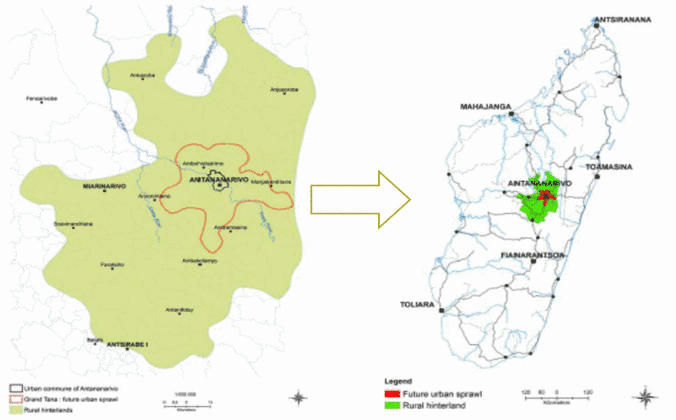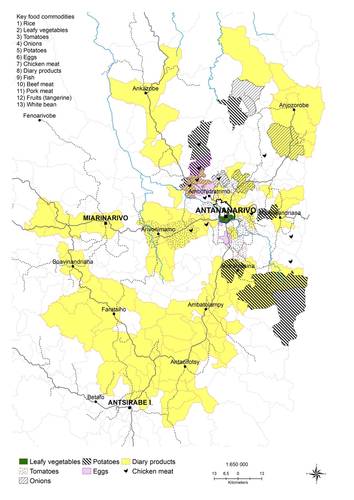Antananarivo, Madagascar
Background
Antananarivo has population of 2.5 million (2018), which concentrates 10 percent of the national population. It has 50 percent of the country’s urban population, with an urban growth rate at 3.5%. It is located in a large alluvial plain, traversed by hills, surrounded by three main rivers with very narrow natural outlet which causes plain frequent flooding. 44 percent of the land (30,000 ha) in Grand Tana is covered by urban agriculture.
The city region food system (CRFS) of Antananarivo
The CRFS of Antananarivo has been defined as a set of 66 municipalities (two urban municipalities (Antananarivo and Ambohidratrimo) and 62 rural communities located less than 100 km away from the city centre. This area produces an enough quantity and diversity of agricultural products which mainly supplies the urban consumption. The CRFS assumes the following criteria:
- Inter-municipal cooperation: 29 municipalities belonging to the OPCI FIFTAMA (Association of municipalities created in 2000) a public inter-municipal cooperation body set up with the aim of implementing the “Grand Tana” project, which materializes the rural-urban linkages in the CRFS.
- Future urban sprawl: 38 municipalities are part of the future urban masterplan for Antananarivo (horizon 2033) and the Integrated Water and Sanitation Program for Antananarivo (PIAA).
- Agricultural economy and food industries: municipalities holding industries and infrastructure to process agricultural raw materials coming from main food value chains (see below).

Key food commodities
The typical diet of individuals in Antananarivo is characterized by insufficient quantity and nutritional value. The diet lacks protein (meat, fish, legumes), dairy and micronutrients, especially vitamin A, iodine and iron. In the urban municipality of Antananarivo, more than a third of households (over 200 000 people) are borderline or severely food insecure.
The value chains prioritized for the CRFS are rice, leafy vegetables, tomatoes, onions, potatoes, eggs, dairy products, meats (beef, pork, freshwater fish, poultry (gasy chicken), broiler) as well as tangerine.
Main climate hazards impacting the CRFS
Main climate hazards (shocks and stresses)
Erratic and intense rainfall: the CRFS is very susceptible to rainfall variability and extreme events, particularly in rainfed agriculture systems. Intense rainfall events often affect food supply (damages on the road network), generating disruptions. Recent large volumes of precipitation combined with floods (1985, 1997, 2001, 2015) and the succession of years of deficit led to periods of drought and water shortages. In general, it has been observed that an intensification of extreme climatic phenomena (cyclones) often caused irreparable damage to infrastructure and productive surfaces. In addition to flooding and extreme rainfall events, the wet season accompanied by heavy rain can also cause landslides in areas located in the hills of Antananarivo.
Variation (rise) in temperatures and heat stress: The generalized increase in temperatures accentuates the phenomena of evaporation/transpiration leading to water stress and/or the drying up of streams and other water bodies. In river basins where plant cover is in decline, a significant runoff phenomenon leads to water erosion and the silting up of lowlands, thus reducing cultivable areas. The low retention/infiltration capacity of the basins also leads to drops in the water table level, thus drying up of the sources at higher altitude.

Impacts on the CRFS
Production
Rainfall pattern disturbance impacts the timing and intensity of the first rains. This impacts the crop calendar, in particular rice cultivation. While the rainy season is delayed (from November-April to December-April), the dry season is extended-lasting up to 7 months (April-November and May-October).
Storage and processing
Prolonged humidity (due to heavy rains, floods and high winds) have impacts on the preconditioning/packaging and overall quality of products to be stored in storage warehouses. This results in significant food loss and consequent rising food prices. Additionally, excessive rise in temperatures cause rapid perishing of products in storage warehouses.
Due to poor road infrastructure, food transport is extremely susceptible to heavy rains and cyclones. Cutoff of roads and bridges cause the supply disruption of raw materials and power cuts lead to breaks in the cold chain, seriously affecting food safety and quality. Given the obsolescence of most of the slaughterhouses in Antananarivo, the climatic variations create practical problems (power and water cuts) as well as health problems for products from slaughterhouses.
Climatic impacts lead to an increase in transport tariffs, which are then reflected in the price of food products. This in turns influences vulnerable households and the income of dockworkers working in the food transportation industry.
Access to markets and consumption
During cyclones (generally from January to March), access to wholesale markets is difficult for consumers. In addition, the supply, which is lower than the demand, leads to an inflation of food prices-heavily impacting the diet of the middle and lower-income classes.
The difference between households lies in their capacity to access food available at the market level. Livelihoods and income levels are often the key factor determining the capacity of households to access nutritious food, influencing the level of consumption and nutrition. As a result, groups without stable occupations are the most susceptible to food insecurity. Food insecurity can lead to poor nutritional situations, especially for young children.
The impacts of COVID-19
The CRFS of Antananarivo is affected by climate-sensitive diseases including acute respiratory infections during the dry and cold seasons, malaria, water-borne and vector-borne diseases during the hot and rainy season. Epidemics are thus among the major risks for Grand Tana. In particular, the city was affected by the pulmonary plague epidemic of 2017 and by measles epidemic between 2018 and 2019.
The COVID-19 pandemic has heavily impacted the CRFS of Antananarivo-significant challenges in marketing agricultural products have been observed. The pandemic has caused rural producers to sell their product at a lower price thus further impacting agricultural production for future seasons. Threatened livelihoods have impacted agricultural production as rural producers could no longer buy seeds and another inputs. Since the beginning of the pandemic, food prices have increased significantly.
In order to help combat COVID-19 and climate-related challenges, the national government will support rural producers in the Analamanga region to continue the production of priority commodities. An emphasis will also be given to retail markets creation of local product markets to sell commodities at slightly higher prices (produced within the CRFS boundaries) for middle and upper-class households to support local farmers. These measures will support the producers in keeping quality standards, all while supporting their livelihood (Zuleta Ferrari, 2020).
Priorities identified to increase the CRFS resilience
Food production:
- Strengthen the resilience of the productive sector to ensure food availability for the city region population.
- Reduce the vulnerability of producers and rural populations (especially women and young people).
- Boost rice production as main value chain and commodity for the CRFS population.
- Support family farming for food security and household income (Food crop & Cash crop).
- Promote and increase practices of urban and peri-urban agriculture (e.g. vegetables gardens in urban areas, school gardens, varieties and practices adapted to urban areas, off-season crops, etc.).
Supply and distribution:
- Promote short food supply chains in times of crisis to minimize losses and avoid disruptions.
- Establish agricultural storage areas (storage shed for agricultural products, municipal units for the production of compost from organic waste from the city markets).
- Create and reorganize municipal markets by promoting partnerships between the City Council and small businesses.
Job creation and enterprise development:
- Promote enterprise development and job creation in rural areas.
- Promote income-generation activities and job creation for urban residents (development service, technical support to small and medium-sized enterprises, partnerships with employers’ organizations, etc.).
Know more
Factsheet |
|---|


